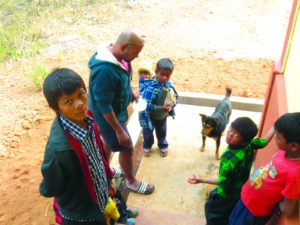The Charism Statement of the Christian Brothers reads: Deeply aware of the Father’s providential presence in life, Edmund Rice [our founder] was moved by the Holy Spirit to open his whole heart to Christ present and appealing to him in the poor. This statement till today grips my heart, and I feel that it sums up, in a profound way, what it means for me to be a Brother in the world today.
MY BACKGROUND AND CALL
I was born on the 7th of April, 1978, into a family with three siblings. I studied in Regina Mundi School in Goa, a school run by the Christian Brothers. I was inspired by the lives of the Brothers. I found in these men not just teachers of subjects, but also mentors who were caring, compassionate and ever ready to reach out. It was this example of the lives of the Brothers that led me to say YES and join the Brothers. I was then asked to do my Higher Secondary in Shillong. After completing my studies, I had to decide whether I was still interested in being in the Congregation. And, I said YES.
MY FOUNDATIONAL EXPERIENCE
I spent a few months doing my Postulancy, following which I joined the Novitiate. It was here, during my first retreat ever, that I was gripped by a deep experience of the love of God. It happened while I was meditating on the Baptism of Jesus. All of a sudden, from deep within me, I felt God as a most loving Father, saying those words to me: “You are my beloved son. I love you.” It was as if the heavens were opened, and I felt embraced and wrapped up in so much love and tenderness, like I had never experienced before. I do believe even now, that it was this profound God-experience that has been, and continues to be, the foundation on which my life as a Religious is built and sustained. As a result of this experience in the Novitiate, I fell madly in love with God, whom I now wanted to know, experience more, and give my whole life to. Towards the end of my Novitiate, I professed my First Vows on the 24th of December, 1996.
BEING PRUNED THROUGH MANY EXPERIENCES
My First Mission was among the Khasi people, in a lovely village called Mawjrong, in Meghalaya. I believe that the seeds for working among people ‘made poor’ were first sown in my heart while I was here. My time in Mawjrong was, however, cut short, as I was sent home to help look after my father, who was diagnosed with cancer. My father passed away in December, 1997. It was during this time that I felt God holding and sustaining me and my family. This deepened my faith in God’s love for me.
During my years of pursuing my Degree (1998-2001), I felt deeply drawn to God’s Word, and began spending a lot of time studying the Scriptures. My life was being driven by a love for the Gospels and the New Testament Letters. The letters of St. Paul gripped me, and I wanted to experience in my heart what Paul experienced—being gripped by the person of Jesus.
After my Degree, I was involved in many ministries in some of our schools—Mount Abu, Challakere, Mumbai and Kurseong. Teaching in these schools, working with students in music and singing, animating youth, conducting sessions on spiritual and other topics that interest youth, accompanying groups for walks, picnics and camps were experiences which I saw gave meaning to their young lives, and also gave me a sense of fulfilment as a Brother.
December 29th, 2005, was the day I professed my Final Vows. During my month-long silent retreat, in preparation for my Final Vows, I knew for sure that Jesus was calling me to an intimacy with him, to giving myself totally to him and to working for his Kingdom.
In the middle of my being transferred to various places, I lost my mother to a yearlong battle against cancer. I was fortunate to have spent almost a year with her during this time. Her passing away on the 4th of October, 2009, left a deep void within me. However, my mother’s faith in the love of God for her, and her deep love for the person of Jesus, particularly during this time of great pain and suffering, continues to inspire me to this day.
I was fortunate to be given the opportunity to pursue a Bachelor’s in Theology in Vidyajyoti College in Delhi. Those were three years of grace! Studying Scripture and other subjects gave me a greater understanding and clarity to my own faith.

BEING A PRESENCE THAT TRANSFORMS
In the year 2015, a letter was sent to us Brothers, asking us to discern whether we would be a part of Our Way into the Future, an invitation of our Congregation calling Brothers to live and work as a community actively engaging with people ‘made poor.’ I accepted the invitation. I now live in a village called Patharlyndan, with three wonderful young brothers. As the document “Identity and Mission of the Religious Brother” says: “The mission is not “what he [a Religious Brother] does” but rather his very life itself made communion with the least.” Engaging with the people in the village in and through their joys and struggles, working together with them in bringing about a transformation in their lives through empowerment, is what I see is my role as a Brother.
How can I make God present in the world today—in the village in which I am working? How can I be, to the people around me, the presence of God—God’s love, God’s mercy, God’s gentleness…? These are some of the questions that I constantly ask myself. I realize that the call to be a Brother can take on different expressions. As I draw inspiration from the Gospels, the more I dwell deeper on them, I see that this is exactly what Jesus was all about—seeking always to make God real to all who met him.
THE CONSTANT CHALLENGE
One of the challenges of being a Brother is to make the vocation of a Brother understood. To many, being a Religious Brother is being ‘half-baked’ or not being intelligent or smart enough to be a priest. I meet many people (some very educated) who look at the vocation of a Brother as not as ‘high’ a calling as the priesthood! Even in so many religious gatherings, the opening statement is often addressed to Fathers, Sisters and Friends—with Brothers left out altogether! This is sadly done more by priests and sisters than by the laity.
I feel that Religious Brothers have a very prophetic role to keep alive the memory of Jesus as Brother. Remembering Jesus who told his followers: “And you are all brothers” (Mt 23:8), we Brothers are challenged to be a presence that makes God incarnate in the world.
RADICAL LOVE AND DISCIPLESHIP
I am very happy as a Brother. I can never imagine myself being anything else! Through all my years, it is especially in my moments of pain and brokenness that I have encountered God. God’s Word in Scripture and my personal prayer time have nurtured me through these years and helped me go through very difficult moments in my life. At every stage of my life I have been drawn—sometimes in spite of myself—closer to Jesus, to a deep love for him and to a radical following in his footsteps.
I pray that young men who sense the call of God to this vocation may have the courage and find the grace to respond to this amazing invitation.
Brother David Ryan Silva CFC: Brother David Ryan Silva CFC completes 25 years in the Congregation of the Irish Christian Brothers. He is presently working together with three Brothers in Patharlyndan, a village in the West Khasi Hills.
To subscribe to the magazine Contact Us























